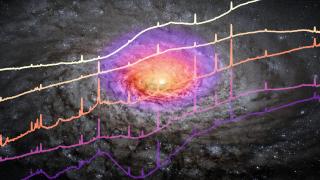Bibcode
Coloma Puga, Miguel; Balmaverde, Barbara; Capetti, Alessandro; Massaro, Francesco; Ramos Almeida, Cristina; Miley, George; Gilli, Roberto; Marconi, Alessandro
Bibliographical reference
The Astrophysical Journal
Advertised on:
12
2023
Journal
Citations
4
Refereed citations
4
Description
Spatially resolved observations of active galactic nuclei (AGN) host galaxies undergoing feedback processes are one of the most relevant avenues through which galactic evolution can be studied, given the long-lasting effects AGN feedback has on gas reservoirs, star formation, and AGN environments at all scales. Within this context, we report results from Very Large Telescope/MUSE integral field optical spectroscopy of TN J1049-1258, one of the most powerful radio sources known, at a redshift of 3.7. We detected extended (~18 kpc) Lyα emission, spatially aligned with the radio axis, redshifted by 2250 ± 60 km s-1 with respect to the host galaxy systemic velocity, and cospatial with UV continuum emission. This Lyα emission could arise from a companion galaxy, although there are arguments against this interpretation. Alternatively, it might correspond to an outflow of ionized gas stemming from the radio galaxy. The outflow would be the highest redshift spatially resolved ionized outflow to date. The enormous amount of energy injected, however, appears to be unable to quench the host galaxy's prodigious star formation, occurring at a rate of ~4500 M ⊙yr-1, estimated using its far-infrared luminosity. Within the field, we also found two companion galaxies at projected distances of ~25 and ~60 kpc from the host, which suggests the host galaxy is harbored within a protocluster.
Related projects

Nuclear Activity in Galaxies: a 3D Perspective from the Nucleus to the Outskirts
This project consists of two main research lines. First, the study of quasar-driven outflows in luminous and nearby obscured active galactic nuclei (AGN) and the impact that they have on their massive host galaxies (AGN feedback). To do so, we have been granted time with the Gran Telescopio CANARIAS (GTC) in the optical and near-infrared ranges
Cristina
Ramos Almeida